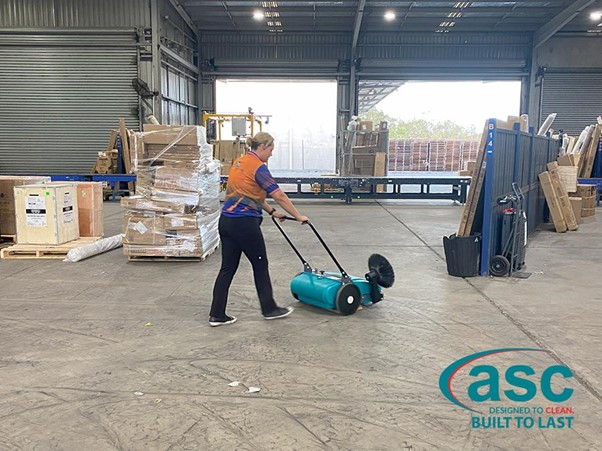A floor sweeper is often our go-to tool for keeping our homes and workplaces clean. It’s quick, efficient, and saves us a lot of time in our daily cleaning routines.
But have you ever considered what happens to the waste it collects?
The proper disposal of floor sweeper waste is more important than you think. It’s not just about keeping our spaces tidy but also about protecting our environment and health.
Let’s see why it’s crucial to dispose of this waste safely and responsibly, ensuring that our trusty floor sweepers do more good than harm.
What Are The Types Of Waste Typically Collected By Floor Sweepers?
Floor sweeper machines, whether manual or powered, are designed to collect various waste types from floors.
The nature of this waste can vary based on the environment in which the sweeper is used. Here are the different types of waste commonly collected by floor sweepers:
- Dust and Dirt: The most common type of waste, including fine particles and soil tracked in from outside.
- Debris: This includes larger particles such as paper scraps, leaves, small twigs, and food crumbs often found on floors in homes, offices, and public spaces.
- Hair and Pet Fur: In residential or pet-friendly areas, sweepers often pick up significant amounts of human hair and pet fur.
- Allergens: Floor sweepers collect allergens like pollen, dust mites, and mould spores, which are not always visible to the naked eye but can significantly impact indoor air quality.
- Liquid Spills: Some advanced floor sweepers are equipped to handle small liquid spills, absorbing the moisture and any particulate matter in the spill.
- Glass Fragments: In areas where glass breakage occurs, floor sweepers can collect tiny shards and pieces of glass.
- Industrial By-Products: In industrial settings, sweepers might pick up metal shavings, sawdust, and other by-products of manufacturing processes.
- Chemical Residues: In some environments, such as laboratories or factories, sweepers may collect residues of chemicals or other hazardous materials.
- Microbes and Bacteria: While not visible, these can be present in the waste collected, especially in healthcare settings or places with high foot traffic.
- Plastic and Synthetic Materials: Bits of plastic, synthetic fibres, and other small non-biodegradable materials can also be collected by floor sweepers.
The variety of waste collected by floor sweepers highlights the importance of understanding the best practices for their disposal, especially considering environmental and health safety.
What Are The Pre-Disposal Steps For Floor Sweeper Waste In Commercial Areas?
In commercial areas, the pre-disposal steps for floor sweeper waste are crucial for ensuring efficient waste management and environmental compliance. Here are some key steps to follow:
Segregation of Waste:
- Recyclables vs Non-Recyclables: Separate materials like paper, plastic, or metal that can be recycled from non-recyclable waste. This helps in reducing landfill waste and supports recycling initiatives.
- Hazardous vs Non-Hazardous: Identify and separate dangerous materials (chemical residues or broken electronics) from regular waste. These require special handling and disposal methods.
Assess Waste Volume and Type:
- Consider the volume and type of waste collected regularly.
- This helps plan the appropriate disposal methods and schedule waste pick-up or recycling services.
Containerising Waste:
- Make sure that waste is collected in proper containers as city regulations specify.
- For instance, sharp objects like glass should be in sturdy, puncture-proof containers to prevent injury.
Labeling and Documentation:
Clearly label containers, especially those containing hazardous waste, and maintain proper documentation for tracking and compliance purposes.
Safe Storage of Waste:
Store the waste in a designated area that is secure and doesn’t pose a health or environmental risk. This is particularly important for hazardous waste.
Cleaning and Maintenance of Equipment:
Regularly clean and maintain the floor sweepers to ensure they function efficiently and don’t contribute to cross-contamination of waste streams.
Employee Training:
Train housekeeping and cleaning staff on proper waste segregation, handling, and disposal procedures. This ensures everyone is aware of their role in responsible waste management.
Compliance with Local Regulations:
Familiarise yourself with and adhere to local regulations regarding waste disposal, especially for hazardous materials, to avoid legal penalties and environmental harm.
These pre-disposal steps are essential in managing floor sweeper waste in commercial areas responsibly and sustainably, contributing to an overall cleaner and safer environment.
What are the Disposal Methods for Floor Sweeper Waste?
Disposing of floor sweeper waste must ensure environmental safety and compliance with local regulations. Here are various disposal methods for different types of waste collected by floor sweepers:
Regular Waste Disposal:
- General Waste Bins: Non-recyclable and non-hazardous waste like dust, dirt, and food crumbs can be disposed of in general waste bins for landfills.
- Incineration: Non-recyclable waste may be incinerated in some areas, but this depends on local waste management policies and facilities.
Recycling:
- Recyclable Materials: Segregate and send recyclable materials like paper, plastic, metal, and glass to local recycling centres.
- Specialised Recyclers: For materials like electronics or batteries from automatic sweepers, use specialised recycling services to process these items safely.
Hazardous Waste Disposal:
- Chemical Waste: Dispose of chemical residues or hazardous materials through designated hazardous waste disposal services.
- Electronic Waste: Electronic components from automated sweepers must be disposed of at e-waste recycling centres.
Composting:
- Organic Waste: Biodegradable materials like food particles and certain natural debris can be composted to create organic fertiliser.
Sanitary Landfills:
- Non-Recyclable and Non-Hazardous Waste: Some waste that cannot be recycled or composted might have to be sent to sanitary landfills.
When disposing of floor sweeper waste, it’s important to consider the environmental impact and adhere to all relevant local, state, and federal regulations.
Final Words:
By adopting responsible disposal habits for floor sweeper waste, we’re not just cleaning our spaces but also caring for our planet. Every small step counts in making a big difference!





